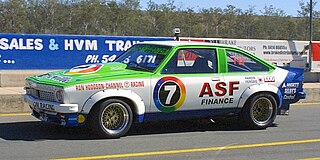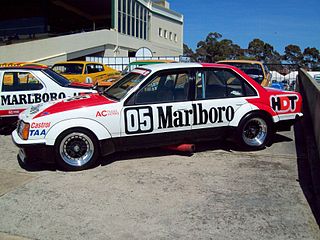The 1981 Australian Touring Car Championship was a CAMS sanctioned motor racing title for drivers of Group C Touring Cars. The championship, which was the 22nd running of the Australian Touring Car Championship, began at Symmons Plains Raceway and ended at Lakeside International Raceway after 8 rounds.

In relation to Australian motorsport, Group C refers to either of two sets of regulations devised by the Confederation of Australian Motor Sport (CAMS) for use in Australian Touring Car Racing from 1965 to 1984. These are not to be confused with the FIA's Group C sports car regulations, used from 1982 to 1992 for the World Endurance Championship / World Sports-Prototype Championship / World Sportscar Championship and the 24 Hours of Le Mans.

The 1982 James Hardie 1000 was the 23rd running of the Bathurst 1000 touring car race. It was held on 3 October 1982 at the Mount Panorama Circuit just outside Bathurst in New South Wales, Australia. The race, which was Round 3 of both the 1982 Australian Endurance Championship and the 1982 Australian Endurance Championship of Makes, was open to cars eligible to the locally developed CAMS Group C touring car regulations with two engine capacity based classes.
The 1983 Australian GT Championship was a CAMS sanctioned Australian motor racing title for cars complying with Group D regulations for GT cars, with Group B Sports Sedans competing by invitation. It was the sixth Australian GT Championship. The championship was won by Rusty French, driving a Porsche 935.
The 1979 Hang Ten 400 was an endurance motor race held at the Sandown Park circuit in Victoria, Australia on 9 September 1979. It was staged over 129 laps of the 3.11 km circuit, a total of 401 km. The race was Round 1 of the 1979 Australian Championship of Makes and as such it was open to Group C Touring Cars. It was the fourteenth in a sequence of annual Sandown long distance races. The race was won by Peter Brock.
The 1986 Australian Endurance Championship was a CAMS sanctioned motor racing title open to Touring Cars as specified in the National Competition Rules of CAMS. The title, which was the sixth Australian Endurance Championship, was contested concurrently with the 1986 Australian Manufacturers' Championship, which was the sixteenth in a sequence of manufacturers championships awarded by CAMS, and the seventh to be contested under the Australian Manufacturers' Championship name.
The 1984 Australian Touring Car Championship was a motor racing competition for Group C Touring Cars. The Championship was authorised by the Confederation of Australian Motor Sport as an Australian National Title. It was the 25th Australian Touring Car Championship, and the last to be contested by Group C cars as new regulations, based on international Group A, were introduced for 1985.
The 1985 Australian Touring Car Championship was a CAMS sanctioned motor racing title for drivers of Touring Cars. It was the 26th running of the Australian Touring Car Championship and the first to be contested using regulations based on the FIA's International Group A regulations after having been run under CAMS home grown Group C rules between 1973 and 1984. The championship began on 10 February 1985 at Winton Motor Raceway and ended on 14 July at Oran Park Raceway after ten rounds.
The 1975 Australian Manufacturers' Championship was an Australian motor racing competition for Group C Touring Cars. It was sanctioned by the Confederation of Australian Motor Sport as an Australian National Title and was the fifth Australian Manufacturers' Championship.
The 1982 Australian Touring Car Championship was a CAMS sanctioned Australian motor racing title open to Group C Touring Cars. It began on 18 February 1982 at Sandown Raceway and ended on 16 May at Oran Park Raceway after eight rounds. The title, which was the 23rd Australian Touring Car Championship, was won by defending champion Dick Johnson, driving a Ford XD Falcon.

The 1983 Australian Touring Car Championship was a CAMS sanctioned motor racing title for drivers of Group C Touring Cars. The title, which was the 24th Australian Touring Car Championship, was contested over a series which began on 6 February 1983 at Calder Park Raceway and ended on 19 June at Lakeside International Raceway after eight rounds.
The 1977 Australian Touring Car Championship was a CAMS sanctioned Australian motor racing championship open to Group C Touring Cars. It was the 18th running of the Australian Touring Car Championship. The championship began at Symmons Plains Raceway on 7 March and ended at the Phillip Island Grand Prix Circuit on 20 November after eleven rounds. 1977 was the second and final time that the series incorporated the longer distance races which made up the Australian Championship of Makes. These races included the Sandown 400 and the Phillip Island 500K, although notably not the Bathurst 1000.

The 1980 Australian Touring Car Championship was an Australian motor racing competition for Group C Touring Cars. Authorised by the Confederation of Australian Motor Sport as a National Title, it was the 21st Australian Touring Car Championship.
The 1983 Australian Endurance Championship was a CAMS sanctioned motor racing title for drivers of Group C Touring Cars. The championship was contested over a six-round series with all rounds run concurrently with those of the 1983 Australian Endurance Championship of Makes.
The 1985 Australian Endurance Championship was a CAMS sanctioned motor racing title for drivers of Touring Cars complying with an Australian version of FIA Group A Touring Car regulations. The championship was the fifth Australian Endurance Championship and the fourth to be awarded as a drivers title.
The 1982 Australian Endurance Championship was a CAMS sanctioned Australian motor racing championship for Group C Touring Cars. It was the second Australian Endurance Championship and the first to incorporate titles for both drivers and makes. The Drivers title was awarded to Allan Moffat and the Makes title to Nissan.
The 1985 Australian Manufacturers' Championship was a CAMS sanctioned motor racing title for car manufacturers. It was the 15th manufacturers title to be awarded by CAMS and the 6th to carry the Australian Manufacturers' Championship name. All championship rounds were open to cars complying with Australian Touring Car regulations, which were based on FIA Group A rules.
The 1981 Australian Endurance Championship was a CAMS sanctioned motor racing title for car manufacturers, contested with Group C Touring Cars. It was the 11th circuit racing manufacturers' championship title to be awarded by CAMS and the first to carry the Australian Endurance Championship name. No driver's title was awarded in connection with this championship.
The 1984 Australian Endurance Championship was a CAMS sanctioned motor racing competition open to Group C Touring Cars. The championship, which was the fourth Australian Endurance Championship, was contested over a five-round series. Titles were awarded for both Drivers and Makes with Allan Moffat winning the Drivers title and Mazda winning the Makes award.
The 1979 Australian Championship of Makes was a CAMS sanctioned Australian motor racing title open to Group C Touring Cars. It was the ninth manufacturers’ title to be awarded by CAMS and the fourth to carry the Australian Championship of Makes name. The title was awarded to Holden.




